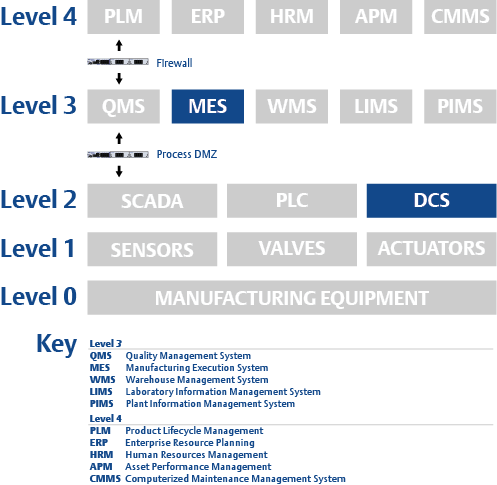As manufacturing companies evolve, there is generally a need for both a Distributed Control System (DCS) system and a Manufacturing Execution System (MES), with both serving as necessary enablers for the efficient plant. They may appear to have overlap in functionality, but they serve unique, complementary roles. There may be a need to harmonize these environments to provide the optimal working environment for your Operations team.
In manufacturing, DCS plays an important role at Level 2 in the ISA-95 and Purdue Model, per the below. As Human Machine Interface (HMI), DCS is a primary interface for operators, enabling monitoring of the process and the issuing of process commands, such as the starting/stopping of equipment and controller setpoint changes. It also typically provides the central alarm management environment for a site. For the purposes of this commentary, please consider DCS and SCADA to offer the same HMI functionality.
In comparison, MES serves as digitalization environment at Level 3, communicating to DCS/SCADA, ERP, and other software platforms at Levels 2, 3, and 4. MES is typically deployed for Electronic Work Instructions, Material Management, Inventory Management, Quality Workflow, Quality Tracking, Electronic Batch Record (eBR), Downtime Tracking, and real-time Production Scheduling.
Both DCS and MES can also be used as data aggregators, data historians, and for visualization of KPI’s such as Overall Equipment Effectiveness (OEE). They are both important data sources for numerous Process Analytics tools that are available.
Purdue Model

Both DCS and MES are necessary for most manufacturing organizations as they work to advance on their automation journey, removing waste and optimizing performance. The transition from Digital Silos to Adaptive Plant in the below, for example, generally requires an increasing level of digitalization to ensure communication, collaboration, and accountability throughout the manufacturing plant and enterprise.
Transition from Digital Silos to Adaptive Plant

Perhaps the bigger question for most companies moving forward is how to best harmonize their DCS and MES environments. In other words, how can you best provide a proper HMI experience as your team members move between these 2 important work environments? The answer, of course, is it is dependent on the type of DCS and MES use cases you have deployed and the mix of Board and Field Operators you have. In a highly automated environment managed mostly with Control Room (Board) Operators, DCS may serve as the primary interface with MES as subordinate. In cases where most work is managed by Plant Floor (Field) Operators, MES may serve as primary interface with DCS as subordinate, often with local HMI at the machines.
MES may also emerge as the primary interface because MES tends to serve a broader team within a manufacturing facility, not only serving Operations but also providing a real-time interface for Quality, Supply Chain, Planners, and other roles. This in no ways minimizes the importance of DCS in manufacturing, especially to the Operations team.
Providing an effective working environment for the Operations team needs to be considered and prioritized. As more software platforms are deployed to support Safety, Quality, Shift Handover, Product Lifecycle, and other critical manufacturing functions, you will need to intentionally consider how to limit the number of applications and HMI’s the Operations team is working from.

The good news is there are standard tools available to support harmonization. Most software platforms offer OPC, MQTT, and/or other communication protocols to allow for bidirectional movement of data between software applications. Many software platforms also offer an application programming interface (API) allowing for the integration of data, services, and capabilities across applications. Many software platforms also support iframe, short for inline frame. Iframe is an HTML element that contains another HTML element within it. This allows for a single HTML interface to provide access to multiple software applications simultaneously.
Both DCS and MES will be necessary for most manufacturing companies as they advance on their automation journey. As automation professionals, we enable and support harmonization, adoption, and change management. When successful with these elements, you will experience desired ROI and enhanced long-term performance as you strive for the Adaptive Plant, perhaps with some elements of Autonomous Operations in time.
Jon Hall
Vice President, Digital Transformation
Adatafy™






